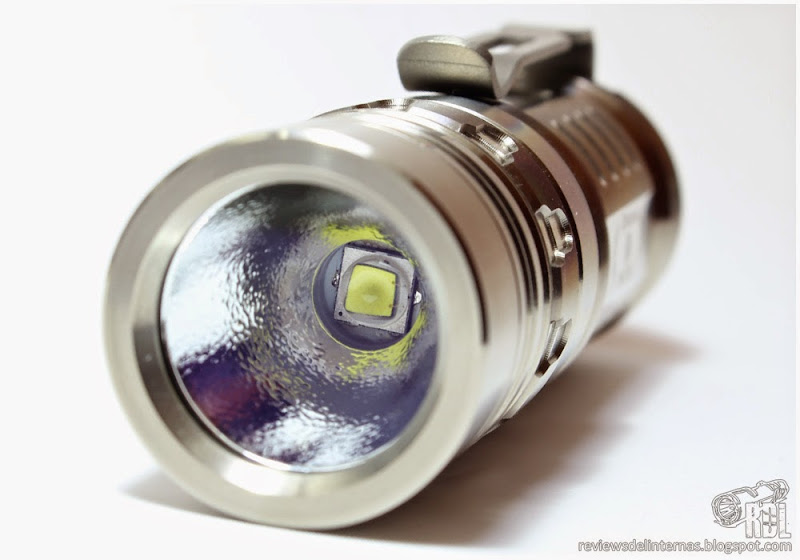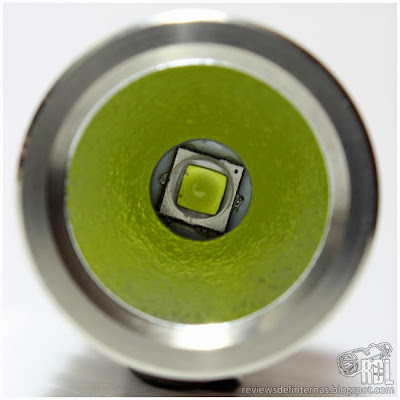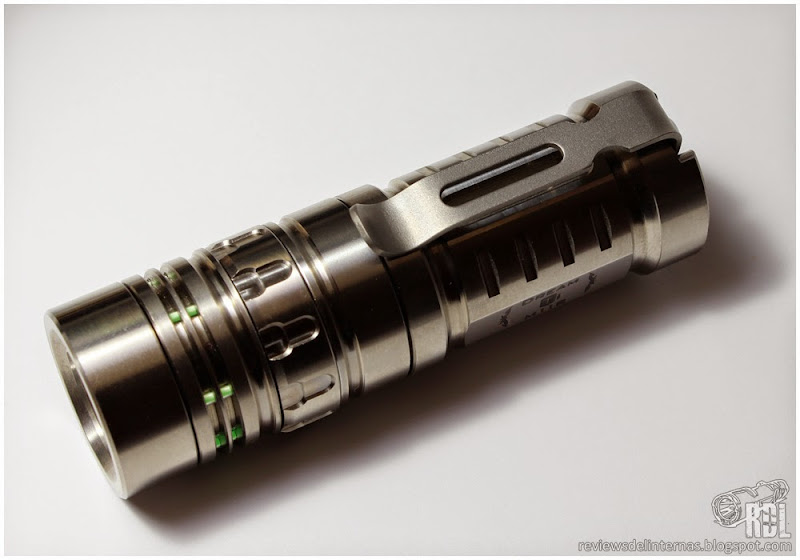
SUNWAYMAN M11R Ti DREAM
LED: CREE XM-L2
Battery: 1x ®CR123A (1x AA, 1x 14500 with optional extender)
Modes: 8 (Low-Medium-Turbo/High-Firefly-SOS-Strobe-Beacon)
Switch: Magnetic Ring
Date: November 2014
links:
Banggood • SUNWAYMAN • RdL • ForoLinternas
INTRODUCTION:
Having one foot already in the Christmas season, brands leverage to tease out their most exclusive and limited models, inviting us, great lovers of their creations to increase our collections with these little works of jewelry that tempt us, and how …
On this occasion, we have on the table the Sunwayman M11R Ti Dream. This is an updated Sirius, one of the best Titanium version, IMHO, SUNWAYMAN been marketed since its creation.
The anodized aluminum M11R is a small EDC flashlight, although not ultra compact or superlight like other competitors, provides an excellent user interface via a magnetic ring of four fixed positions through which we can select the different modes , lacking completely a mechanical switch.
The first titanium version of this flashlight, nicknamed by the brand as M11R Sirius, which we saw several months ago, moved all the natural charm of the base version to a new level of exclusivity, offering an exquisite fully titanium mechanized torch.
Now, SUNWAYMAN has released a new update for this model, now nicknamed Ti Dream that shares the design of Sirius now with six small vials of tritium among its dissipating fins and now incorporates an XM-L2 as LED emitter. In addition, global production of this model is limited to only 300 units.
The packaging also has a new design, now coming presented in the original military type plastic box, where inside, generously surrounded by protective foam found in two separate cuts, flashlight and its sheath containing one game spare o-rings and wrist strap with carabiner.
If we remove the protective foam in the background we found the manual, and warranty card flashlight and a small brochure with all the latest manufacturer news.
EXTERIOR FINISH:
The exterior finish of the Ti Dream, like the Sirius is just great. Fully mechanized TC4 titanium, extremely good polished surfaces, almost a work of goldsmiths.
It has only two levied on the sides of the tube with the logo and brand in a plane and the model in another. Being a limited number run of units, there is not serial number on it, like we saw in the V11R Mirage.
The external machining is quite different from the base version of the M11R anodized aluminum. Knurling areas of the base version have been replaced for different sophisticated machining forms. The magnetic ring is surrounded by slits to facilitate its operation, and the central area of the tube has several tracks surrounding the various planes which compose it.
The tail of the flashlight maintains its original look with a flat base that allows us tailstand smoothly since the clip fasteners profile is below. On the side have a hole for the carabiner or wrist strap.
Light optics comes clean and in perfect condition. A crystal lens with anti-reflective treatment and a textured reflector focuses properly the XM-L2 at the bottom.
The bezel is flat, followed by a small area with several dissipating fins before reaching the magnetic ring. Between fins six holes are drilled longitudinally in which the tritium vials are housed, shown in two sections each through fins free space fins.

The tritium color is typical “radioactive” green, very bright and perfectly reachable under low ambient light.
Inside we see the positive battery contact for brass or copper, surrounded by an insulating black. Two small Phillips screws holding a metal cover that prevents us glimpse the flashlight circuit.
Threads, with just two wires, have a great square cut. Being fully titanium machined flashlight there is the typical gritty feeling to screwing and unscrewing, but not particularly upsetting. Compared with Sirius, the threads have a little more tolerance, whereby the gritty feel is way lower.
The tube has a substantial wall thickness, providing a feeling of stiffness and high hardness. In the background we see a spring to the negative battery contact. Flashlight lacks mechanical switch, so that no electronics in the tube.
The clip comes installed, as inverted L-shaped, screw in the tail by two allen screws. The “spike” accessory (not included as standard on this model) can be installed in either threaded screw holes clip.
USER INTERFACE:
As in the Sirius, this Ti Dream differs by having 8 modes compared to the basic version of the M11R which has only six.

Sunwayman has implemented a dual mode, sharing the same detent for the high and turbo modes,separated by a time-controlled stepdown, which we’ll see in more detail in the section reserved for stepdown performance.
Therefore, the sequence of modes is as follows:

The rotating magnetic ring, unlike the variable continuous adjustment used in the V1xR, has 4 fixed positions: Off, Low, Medium mode and Turbo / High mode.
To access the special modes have to make different combinations, all very simple. Extra modes are firefly mode (ultra-low mode under 1LM) and Beacon mode, a location flash which emits a flash approximately each two seconds.
The distribution of the modes is quite good, with outputs well balanced within the desirable range for a flashlight with these characteristics.
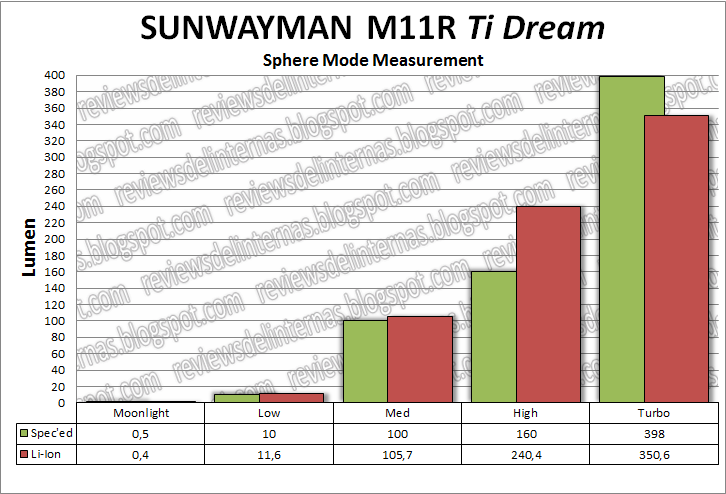
<span class=““here”:[DIY] Esfera integradora con función datalogger - ForoLinternas - Foro sobre linternas y tecnología LED. details More point. ignition after seconds 120 and 30 between of reading highest the of value as taking FL1”:Estándares ANSI NEMA FL1 - ForoLinternas - Foro sobre linternas y tecnología LED, NEMA “ANSI procedure the following taken are measurements All”>
As you can see, the distribution of modes seems to be well provided with balanced outputs for the size and use of a flashlight with these characteristics. The Turbo mode is quite far from brand spec’s, and the High mode seems to be specified for 3V primary batteries.
Finally, we are now checking the parasitic standby current draw. Fully lacking a mechanical switch, the Ti Dream is virtually always on, even with the ring in off detent. SWM speaks of a current 50uA (0.05mA), but I could see that we get different results depending on the type or state of battery that we use.
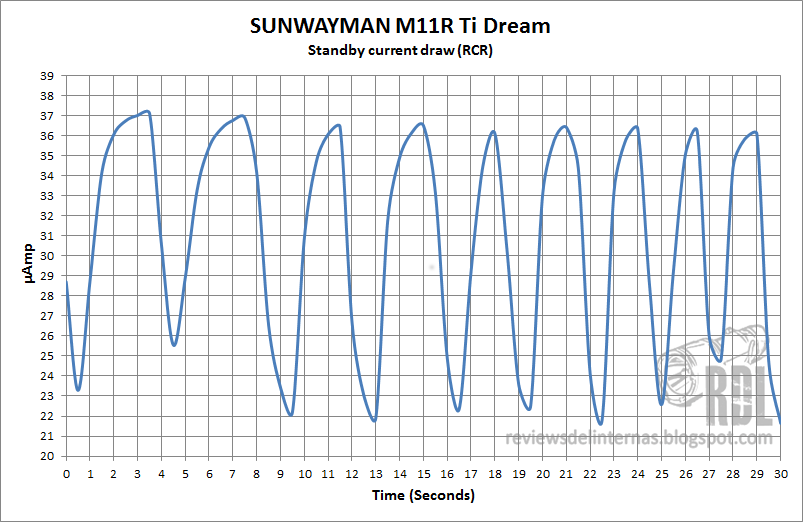
Unfortunately, there is no feasible lock-out option as the threads are fully conductive, with the removal of the battery being the only sure way to avoid such parasitic draw.
PERFORMANCE:
As it is a collector’s item we will focus this section on how SWM time-controlled stepdown performs for Turbo-to-high mode sequence. To do this I changed the template graphs so that the X axis labels showing time is divided in seconds instead of minutes as I usually do. The Y axis is intact and shows the output of light captured by the integrating sphere, only at a frequency of two samples per second instead of my usual sampling of 4 per minute.
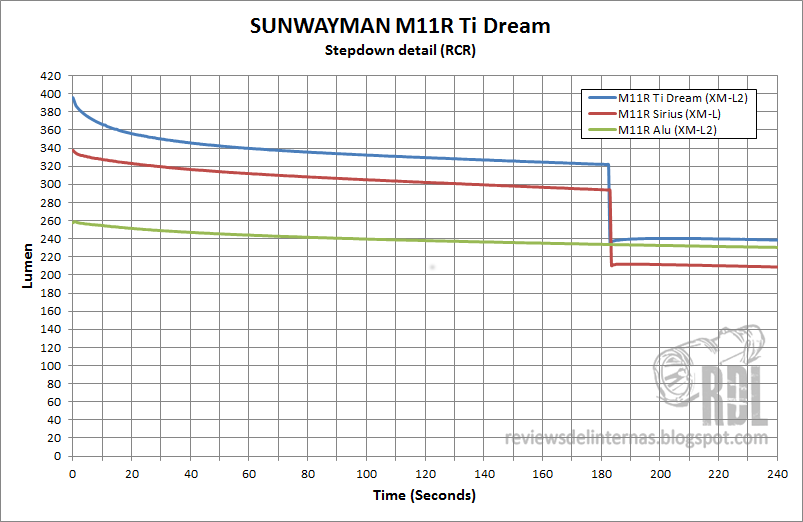
In the graph we represented by three lines of different colors, the first four minutes of continuous use of the three versions of M11R I have. Interestingly, the Ti Dream offers nearly identical to the Sirius line only with a few extra 25LM, resulting in 8.33% of this extra performance XM-L2 (unknown bin) versus XM-L U3 of Sirius.
The XM-L2 base version lacks stepdown, and contrary to what happens with other brands that offer titanium alternatives to existing models aluminum is less powerful (during these first minutes of use).
BEAM PROFILE:
The M11R Ti Dream offers a clearly floodier beam, with a large central hotspot not too defined that progressively degrades very gradually merging with the spill:


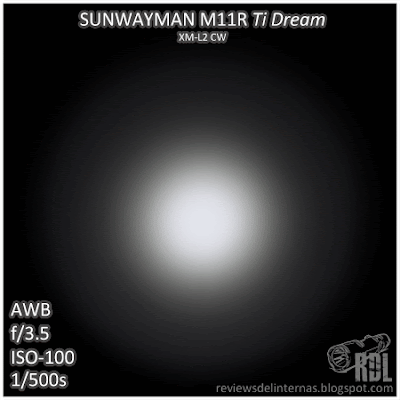
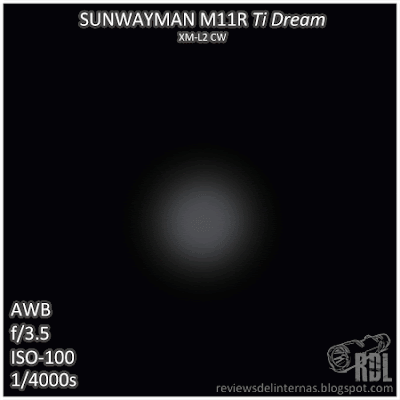
Nothing changes compared to previous versions, since they use the same reflector. Maintains a mainly flood profile, and retains the slight darker than the rest of the spill light ring surrounding the hotspot.

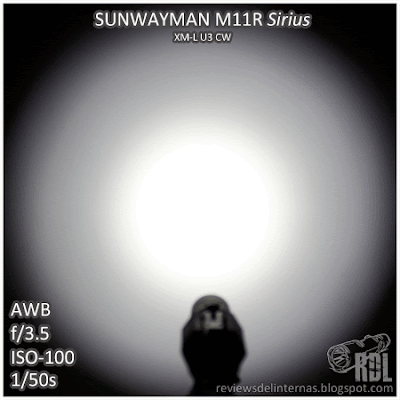

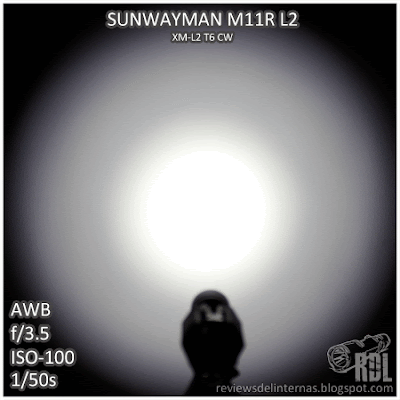
The tint, for being a Cree XM-L2 is not bad at all. No colour tone predominates, being a very very good CW, the best I’ve seen so far out of a Cree XM-L2-edge. Looks like Sunwayman has cherrypicked it! Wow ![]() …
…
PERSONAL CONCLUSION:
Little to say here. As a lover of this kind of unique lights SUNWAYMAN know how hounding and unusual versions are almost always become essential to my collection. With a V10R Ti +, M11R Sirius and several V11R Mirage, it was clear that there was a gap for this Ti Dream. One can spend hours examining almost with a magnifying glass enjoying every single detail of your body, and praising the exquisite skill used for machining. The trits, whether an idea already known by many for modders CPF and company, offers something we’ve never seen a factory flashlight. Beyond its visual appeal, are also extremely useful for locating the flashlight when we are in complete darkness.


EagTac D25C Clicky Ti • SWM M11R Sirius • SWM M11R Ti Dream • SWM V10R Ti+ • Jetbeam TCR10
Its user interface with a magnetic ring with fixed positions seems much more practical, because we have something with her sisters V1xR not have, and we know perfectly how we are and therefore we can make estimates about reliable runtime at our disposal. With continuously variable adjustment, we only know for sure when we stay at maximum or minimum end.
Negatives: The only negative point from an objective point of view I can put for the new M11R Ti Dream is the absence of an engraved unique run/serial number, like they made in Sunwayman V11R Mirage, and I do not understand why they don’t reproduced it here in the Ti Dream or previous Sirius. I would have also liked the super-low mode was in the first detent, but that might be something totally subjective.
Positives: One out of 300 to be manufactured is already in itself a good argument for me. Furthermore this flashlight, though not exactly budget price, maintains a reasonable price if we consider tritium vials and update the issuer against the market price of the previous version. A little gem in addition to beautiful and unique is perfectly usable with a cast of excellent modes and mature user interface.
